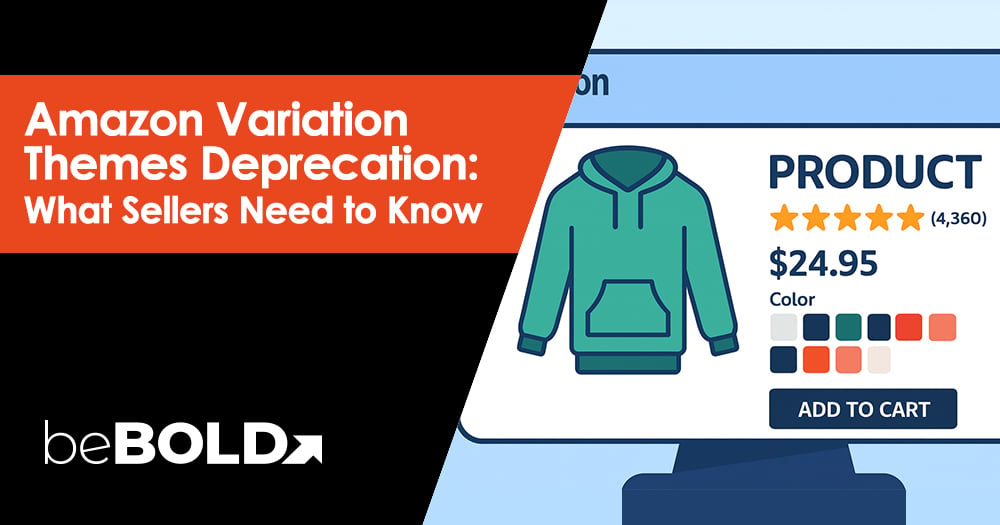Key Highlights
- Amazon will begin removing deprecated variation themes on September 2, 2025, with a final deadline of November 30, 2025.
- After seller pushback, only themes with zero sales in the past 12 months will actually be removed. 📉
- Core themes like Size, Color, and Style are safe. ✅
- Sellers should still audit their catalogs and migrate listings to supported variation structures. 🔍
- If ignored, your listings could lose parent-child relationships, scatter reviews, and drop in rankings. 🚨
Amazon sellers, brace yourselves: beginning September 2, 2025, Amazon is rolling out one of its biggest catalog cleanups in years by removing deprecated variation themes. While the original announcement caused widespread concern, Amazon has since walked back its initial plan, easing the pressure for most sellers. Still, if you don’t act, you risk broken listings, scattered reviews, and a major drop in visibility, right before Q4.
In this guide, we’ll break down what’s changing, the updated timeline, the risks to your listings, and how to prepare.
What Are Amazon Variation Themes?

Source: Amazon
Selling products on Amazon relies heavily on how well listings are structured. To help sellers organize their listings, Amazon introduced the consent of variation themes, or the attributes that link products under a parent listing, for example, size, color, flavor, scent, or style. They make it easier for shoppers to browse options without navigating multiple pages, while also helping sellers consolidate reviews and ranking power.
These themes act as the backbone of Amazon’s parent-child system. A strong variation structure means one parent page can capture more traffic, concentrate ad spend efficiently, and pool reviews to build buyer trust. For example, if you sell a bag in 16 colors and two sizes, all 18 options can live under one parent, making it simple for customers to shop and boosting your ranking potential.
However, over time Amazon’s catalog became cluttered with thousands of niche or irrelevant themes, everything from rarely used pattern types to oddly specific attributes. Many sellers also misused themes, forcing products that weren’t truly “functionally identical” into variation families, which created catalog noise. This not only confused buyers but also complicated Amazon’s AI‑driven search (Rufus), which depends on clean, standardized attributes to recommend products accurately.
That’s why Amazon is now deprecating them: to streamline categories, eliminate misuse, and improve both the shopping experience and long‑term catalog consistency.
The Timeline: From September 2 to November 30, 2025
Amazon has set out a two-phase removal schedule that sellers need to track carefully. Understanding these deadlines is critical, as missing them could cause your listings to break apart just as Q4 demand peaks.

September 2, 2025
- Amazon begins removing flagged variation themes from product templates, flat files, and Seller Central UI.
- Listings tied to these themes will return the error “the value specified is invalid” if updated.
- At this stage, only themes with zero sales in the last 12 months are actively removed, meaning many active families remain untouched. However, sellers attempting updates with deprecated themes will still encounter errors.
November 30, 2025
- Final removal deadline.
- Any ASINs still tied to deprecated themes at this point could have parentage break, where children are split into standalone listings.
- This deadline also means sellers have until the end of November to rebuild families under accepted themes, a critical task given that it coincides with Q4 sales.
- Child ASINs may remain live but as standalone products with no shared reviews or rankings, which fragments visibility and reduces trust signals for buyers.
Amazon’s Rollback: What Changed?
The initial announcement created panic, with over 65,000 to 74,000 variation themes were marked for removal across 1,800 product types, from apparel to pet supplies.
However, in late August, Amazon clarified:
- Only themes with no sales in the past 12 months will be removed.
- Core themes (Size, Color, Style, Flavor) are safe.
- Active variations with sales will continue working normally.
This rollback significantly reduces the impact, but sellers should still audit, optimize and future-proof their Amazon listings.
Risks of Ignoring the Variation Theme Update
If your catalog still uses deprecated themes, here’s what could happen:
- Broken Parentage: Child ASINs split into individual listings, which removes the unified shopping experience and can severely reduce conversion rates. Once split, each child SKU has to fight for visibility independently.
- Scattered Reviews: Reviews once shared across a parent listing fragment across children, weakening social proof. A family of 500 reviews could suddenly become several listings with only a handful each. This loss of credibility can directly hurt conversion rates.
- Lost Visibility: Parent ASINs drive discoverability and click-throughs. If they break apart, rankings scatter and Amazon’s AI-powered Rufus may deprioritize your listings because of non-standard attributes, leaving you with weaker organic reach.
- Ad Inefficiency: Sponsored ads tied to a parent listing lose history and performance data, forcing campaigns back into learning mode. This not only increases ACOS but also reduces the ability to scale efficiently.
- Q4 Disruption: Timing right before Prime Day and the holiday rush means any breakage could slash seasonal sales. Rebuilding parentage under pressure also risks triggering variation abuse flags, which may cause listing suppression and weeks of lost revenue.
How to Prepare: Your Step-by-Step Guide
Getting ahead of Amazon’s variation theme removal requires a clear action plan. By following these steps, you can prevent broken listings, protect reviews, and maintain ranking strength during this transition.

Audit Your Listings
- Download Category Listing Reports (CLRs) and look for themes marked “Deprecated: Do Not Use”.
- Use tools like Amazon’s Rufus AI assistant or third-party checkers to verify which ASINs are at risk.
- Double-check attribute names for spelling and casing consistency (e.g., “Lavender” ≠ “lavender”), since mismatches can block re‑aggregation.
Rebuild Parentage Where Needed
- Delete the existing parent ASIN (children remain in catalog).
- Remove parentage attributes (Parent SKU, Parentage Level, Variation Theme Name) from child ASINs.
- Create a new parent ASIN with an approved variation theme.
- Reattach child ASINs, making sure attributes exactly match Amazon’s current dictionary.
- Use flat file uploads where possible, since they provide more precision than manual Seller Central updates.
Prioritize Top Sellers
- Start with your best-performing listings to protect rankings and reviews ahead of Q4.
- Audit categories most impacted—apparel, beauty, pet products, and consumer electronics—since these carry the highest number of deprecated themes.
Validate and QA
- Check that reviews re‑aggregate correctly after propagation (24–48 hours).
- Confirm search facets display the correct attributes and that the child matrix shows properly.
- Ensure no children are stranded or suppressed in inventory.
- Run a sanity test by searching your products with Rufus AI to confirm discoverability.
Why Is Amazon Doing This?
Amazon’s end goal is to improve the customer shopping experience and strengthen its AI-driven search (Rufus). Clean, standardized attributes help Rufus deliver more accurate recommendations and prevent catalog misuse.
For sellers, this is an opportunity to tighten catalog management and align with Amazon’s long-term push toward AI-driven discovery.
Final Takeaway: Be Proactive, Not Reactive
Amazon’s rollback reduced the immediate risk, but sellers shouldn’t get complacent. Auditing your variation themes now protects rankings, reviews, and sales velocity during Q4 and beyond.
At beBOLD Digital, we help brands audit catalogs, restructure parent-child ASINs, and future-proof Amazon listings against disruptive policy changes like this. Whether you’re in beauty, pets, or emerging niches, our Amazon SEO and catalog management expertise ensures your products stay discoverable and competitive.
Contact beBOLD Digital today to protect your Amazon listings and maximize your visibility before the holiday rush.
Frequently Asked Questions (FAQ)
What exactly are deprecated variation themes?
Deprecated variation themes are outdated or rarely used attributes (like old pattern or obscure style types) that Amazon is phasing out to improve catalog clarity and search performance.
Will core themes like Size and Color be removed?
No. Amazon clarified that essential themes like Size, Color, Style, and Flavor remain supported. Only themes with zero sales in the last 12 months will be removed.
What happens if I don’t update my listings?
Your parent-child ASINs could break apart, reviews may scatter across child SKUs, and rankings can drop. This fragmentation makes it harder to compete in search results and reduces buyer trust.
Do my products disappear if a variation theme is removed?
No. Child ASINs will remain active as standalone listings. However, you’ll lose the benefits of shared reviews, combined rankings, and unified ad spend.
How do I check if my listings are affected?
Download Category Listing Reports (CLRs) in Seller Central and look for any themes flagged as “Deprecated: Do Not Use.” You can also use third-party tools like Vanessa Hung’s Amazon Theme Checker.
Why is Amazon doing this?
Amazon is cleaning up its catalog to eliminate misuse, improve the shopping experience, and support its AI-driven search tool Rufus, which relies on standardized attributes.
When should I fix my listings?
Start as soon as possible—especially for top sellers. The official removal begins September 2, 2025 with the final deadline on November 30, 2025, right before Q4 peak sales.











Comments